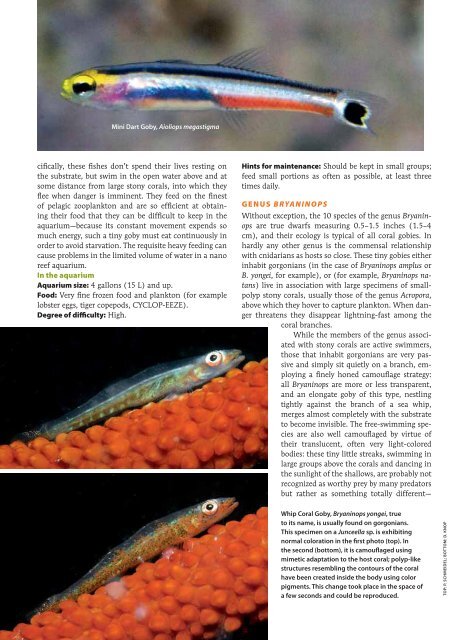Create successful ePaper yourself
Turn your PDF publications into a flip-book with our unique Google optimized e-Paper software.
Mini Dart Goby, Aioliops megastigma<br />
cifically, these fishes don’t spend their lives resting on<br />
the substrate, but swim in the open water above and at<br />
some distance from large stony corals, into which they<br />
flee when danger is imminent. They feed on the finest<br />
of pelagic zooplankton and are so efficient at obtaining<br />
their food that they can be difficult to keep in the<br />
aquarium—because its constant movement expends so<br />
much energy, such a tiny goby must eat continuously in<br />
order to avoid starvation. The requisite heavy feeding can<br />
cause problems in the limited volume of water in a nano<br />
reef aquarium.<br />
In the aquarium<br />
Aquarium size: 4 gallons (15 L) and up.<br />
Food: Very fine frozen food and plankton (for example<br />
lobster eggs, tiger copepods, CYCLOP-EEZE).<br />
Degree of difficulty: High.<br />
Hints for maintenance: Should be kept in small groups;<br />
feed small portions as often as possible, at least three<br />
times daily.<br />
GENUS BRYANINOPS<br />
Without exception, the 10 species of the genus Bryaninops<br />
are true dwarfs measuring 0.5–1.5 inches (1.5–4<br />
cm), and their ecology is typical of all coral gobies. In<br />
hardly any other genus is the commensal relationship<br />
with cnidarians as hosts so close. These tiny gobies either<br />
inhabit gorgonians (in the case of Bryaninops amplus or<br />
B. yongei, for example), or (for example, Bryaninops natans)<br />
live in association with large specimens of smallpolyp<br />
stony corals, usually those of the genus Acropora,<br />
above which they hover to capture plankton. When danger<br />
threatens they disappear lightning-fast among the<br />
coral branches.<br />
While the members of the genus associated<br />
with stony corals are active swimmers,<br />
those that inhabit gorgonians are very passive<br />
and simply sit quietly on a branch, employing<br />
a finely honed camouflage strategy:<br />
all Bryaninops are more or less transparent,<br />
and an elongate goby of this type, nestling<br />
tightly against the branch of a sea whip,<br />
merges almost completely with the substrate<br />
to become invisible. The free-swimming species<br />
are also well camouflaged by virtue of<br />
their translucent, often very light-colored<br />
bodies: these tiny little streaks, swimming in<br />
large groups above the corals and dancing in<br />
the sunlight of the shallows, are probably not<br />
recognized as worthy prey by many predators<br />
but rather as something totally different—<br />
Whip Coral Goby, Bryaninops yongei, true<br />
to its name, is usually found on gorgonians.<br />
This specimen on a Junceella sp. is exhibiting<br />
normal coloration in the first photo (top). In<br />
the second (bottom), it is camouflaged using<br />
mimetic adaptation to the host coral; polyp-like<br />
structures resembling the contours of the coral<br />
have been created inside the body using color<br />
pigments. This change took place in the space of<br />
a few seconds and could be reproduced.<br />
TOP: P. SCHMEIDEL; BOTTOM: D. KNOP<br />
60 CORAL

















